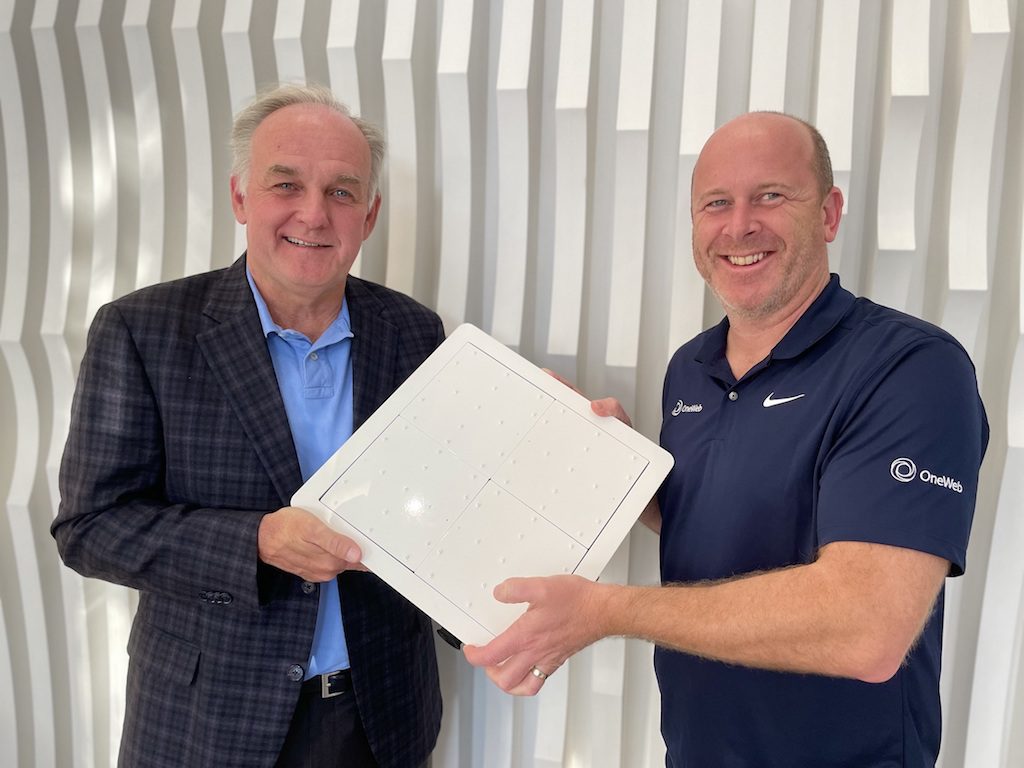
Tracy Trent, President GDC Advanced Technology, and Ben Griffin, VP Mobility, OneWeb, were at the 2021 Airline Passenger Experience Association (APEX) conference in California for the announcement of the development of their new LEO in-flight connectivity terminal.
London-based Low-Earth Orbit (LEO) satellite constellation operator OneWeb has partnered with GDC Technics’ California-based aviation engineering and technical services provider GDC Advanced Technology to create a new In-Flight Connectivity (IFC) terminal that will enable airlines to connect their aircraft to OneWeb’s LEO network, according to a joint development agreement announced by the two companies last week.
Based on electronically steered antenna (ESA) technology developed by Ball Aerospace, the terminal has already undergone early lab and ground testing at GDC’s facilities in Fort Worth Texas. Under the agreement, the two companies will develop a terminal that will initially be available in two sizes: a traditional ARINC 791 for larger commercial airliners and a smaller installation for regional and business jets.
GDC describes the design of the terminal as consisting of an antenna with no moving parts and a total of four line replaceable units (LRUs).
“The LRUs consist of the transmit antenna array, the receive antenna array, the MODMAN and a power source. GDC designs and manufactures the arrays. Included are Ball’s Ku sub arrays. The Ball technology was developed for military applications and has been in service for several years,” Stephen Rice, Vice President of GDC Technics, told Avionics International in an emailed statement.
The design of the terminal is configured so that each array is fully sealed and requires no active cooling or radome. Rice said GDC does not anticipate any changes to the design, but will evaluate it once the flight testing phase of the development program begins.
Airlines will be able to use the terminals for both LEO and Geostationary Orbit (GEO) satellite connectivity on their aircraft.
“The antenna will be sized and powered to be capable of closing links with GEO networks. It is an actual full definition ESA. The MODMAN will manage the switch between networks using multiple modems as required,” Rice said.
The joint development agreement between the two companies comes following 18 months of research completed in partnership with “one of the industry’s leading airlines,” according to OneWeb. Several other unnamed satellite operators were also involved in the research, which will culminate in the eventual rollout of a terminal capable of connecting to OneWeb’s full LEO constellation.
In an emailed statement to Avionics, OneWeb confirmed the current status of the rollout of its LEO satellite network includes the launch of 358 satellites—more than 50% of the full constellation—orbiting at 1,200 kilometers above the Earth.
“The full constellation will comprise of 648 satellites – with the full network scheduled for completion mid-2022 – with global coverage from the end of 2022. Aviation services will be online from mid-2023, in line with the expected certification of the aviation terminals,” Nick Maynard, director of marketing for OneWeb, said.
Maynard said OneWeb has held introductory meetings with several airlines in different regions of the world and will become the “first LEO operator to offer global service to aviation customers.”
The OneWeb-GDC agreement includes development of supplemental type certificates (STCs) for several aircraft types with “major airframe manufacturers (OEMs),” according to OneWeb. Initial flight testing of the new terminal is scheduled to begin in the first quarter of next year on a Boeing 777.